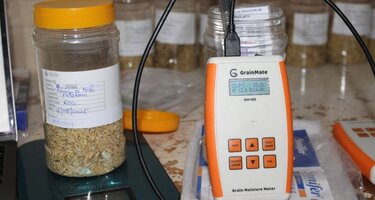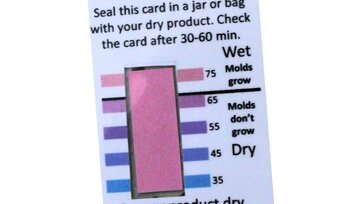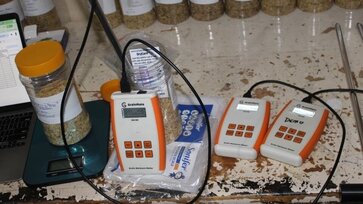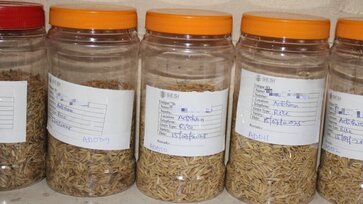DryCard™ now helps rice farmers to reduce post-harvest losses
The DryCard™ is a low-cost tool that helps farmers check if dried food is safe for storage by detecting humidity levels. With support from the Fund for the Promotion of Innovation in Agriculture (I4Ag) and partners, it has now been adapted to the use with rice. This allows rice farmers to reduce spoilage, improve food safety, and protect their income.
In many parts of the world, farmers and traders face a persistent challenge after harvest: keeping crops safe from mold. Grains, beans, nuts, and dried fruits may appear dry to the eye, but hidden moisture can create the perfect conditions for mold to grow. This not only leads to lost foodstuff but can also result in the development of harmful toxins that pose serious risks to food safety and health.
The DryCard™, a simple yet impactful invention developed by the University of California, Davis, offers a practical solution to this problem. Designed to be low-cost and easy to use, the DryCard™ allows farmers, traders, and food processors to determine whether a food product is truly safe for storage. The card contains a humidity-sensitive indicator strip that changes color based on moisture levels. When the strip turns pink, it signals that the product is still too moist and at risk of mold. When it turns blue, the product is dry enough to be safely stored. To use the card, one simply places a sample of the dried product and the DryCard™ together in a sealed jar or bag, waits between 30 and 60 minutes, and then checks the result.
DryCard™ now adapted to rice
Until now, the DryCard™ could not be used accurately to determine the moisture level of rice. But with i4Ag support, the DryCard™ has now been adapted to provide reliable readings for rice. This development means rice farmers in countries like Ghana and Kenya can now use the card to determine exactly when their harvest is safe to store. To calibrate and validate the DryCard™ for use with rice, grain samples were collected from smallholder farming communities across two agro-ecological zones in the Ashanti region of Ghana. These samples were then dried to specific grain moisture levels and subsequently used to calibrate the cards' color scale for rice.
The project, implemented together with the private sector partner Saving Grains 301 GmbH and local training providers and research institutions, provides training on improved post-harvest management practices to farmers and aggregators. This includes the use of hermetic storage bags, innovative drying technologies and moisture content control.
Because the DryCard™ is inexpensive, reusable, and easy to understand, it is especially useful in rural areas and places where access to costly electronic moisture meters is limited. It empowers farmers and traders to make informed decisions about storage, helping to reduce post-harvest losses and protect both food quality and livelihoods.
Now adapted for use with rice, the DryCard™ is ready to make a meaningful impact in Ghana, Kenya and around the world. Its simplicity, affordability, and effectiveness make it a powerful example of how small innovations can lead to significant improvements in agricultural resilience and food security.
This project is part of the Sustainable Agricultural Supply Chains Initiative (SASI). The SASI promotes green, fair and inclusive agricultural supply chains. Together with politics, business and civil society, it puts sustainability issues on the agenda and shapes the political discourse. The initiative is implemented by GIZ on behalf of BMZ.



